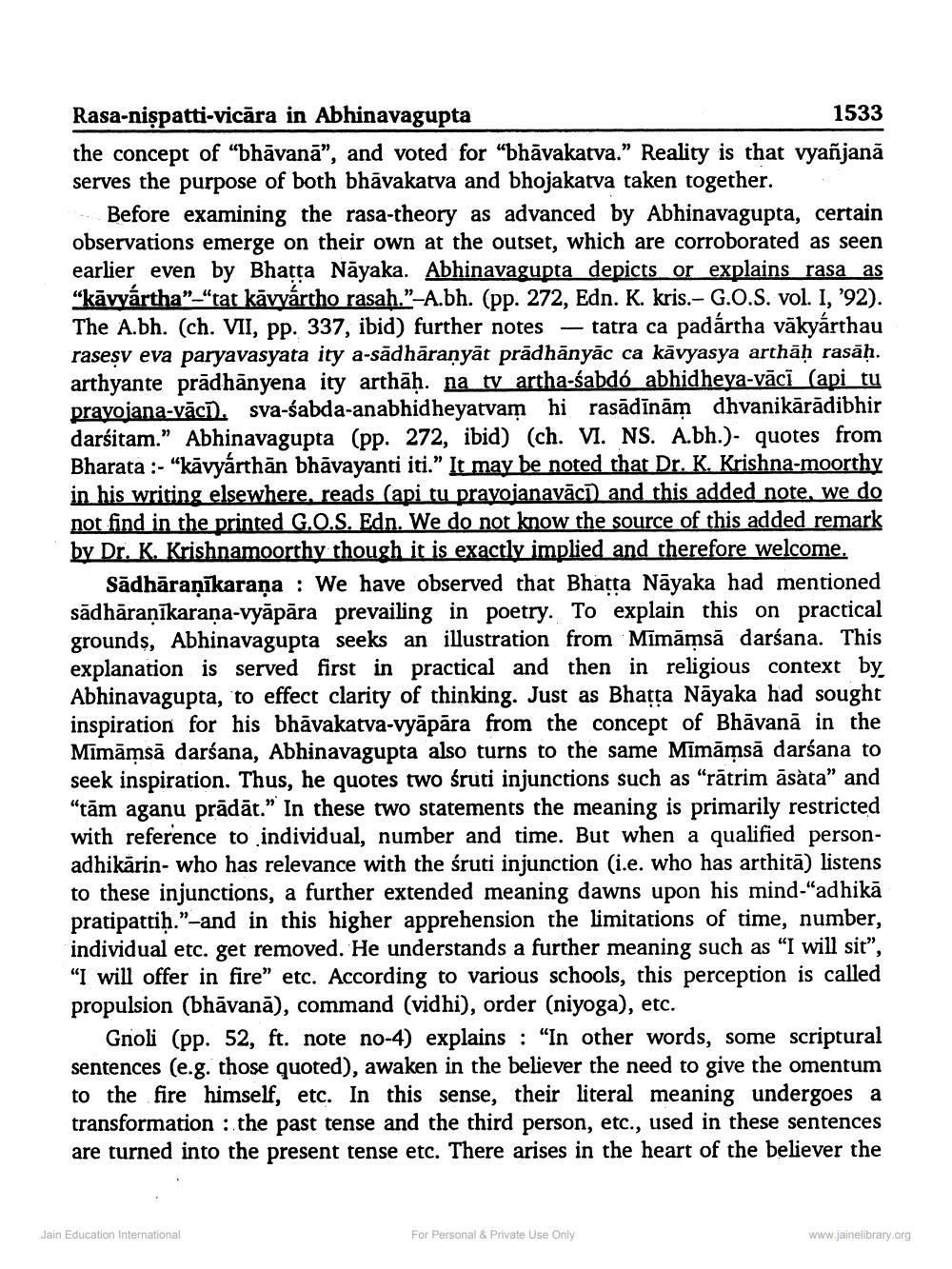________________
Rasa-nispatti-vicāra in Abhinavagupta
1533 the concept of "bhāvanā", and voted for "bhāvakatva." Reality is that vyañjanā serves the purpose of both bhāvakarva and bhojakarva taken together.
Before examining the rasa-theory as advanced by Abhinavagupta, certain observations emerge on their own at the outset, which are corroborated as seen earlier even by Bhatta Nayaka. Abhinavagupta depicts or explains rasa as "kāvvártha"-"tat kāvyártho rasah."-A.bh. (pp. 272, Edn. K. kris.-G.O.S. vol. I, '92). The A.bh. (ch. VII, pp. 337, ibid) further notes — tatra ca padártha väkyárthau rasesv eva paryavasyata ity a-sādhāranyāt prädhänyāc ca kävyasya arthāh rasah. arthyante prādhānyena ity arthāh. na ty_artha-sabdó abhidheya-vācī (api tu pravoiana-vācī. Sva-sabda-anabhidheyatvam hi rasādīnām dhvanikārādibhir darsitam." Abhinavagupta (pp. 272, ibid) (ch. VI. NS. A.bh.)- quotes from Bharata :- "kāvyárthān bhāvayanti iti.” It may be noted that Dr. K. Krishna-moorthy in his writing elsewhere. reads (api tu pravojanavācī) and this added note, we do not find in the printed G.O.S. Edn. We do not know the source of this added remark by Dr. K. Krishnamoorthy though it is exactly implied and therefore welcome.
Sādhāranīkarana : We have observed that Bhatta Nāyaka had mentioned sādhāraṇīkarana-vyāpāra prevailing in poetry. To explain this on practical grounds, Abhinavagupta seeks an illustration from Mīmāmsā darśana. This explanation is served first in practical and then in religious context by. Abhinavagupta, to effect clarity of thinking. Just as Bhatta Nāyaka had sought inspiration for his bhāvakarva-vyāpāra from the concept of Bhāvanā in the Mimāmsā darśana, Abhinavagupta also turns to the same Mimāmsā darśana to seek inspiration. Thus, he quotes two śruti injunctions such as "rātrim āsata" and "tām aganu prādāt.” In these two statements the meaning is primarily restricted with reference to individual, number and time. But when a qualified personadhikarin- who has relevance with the śruti injunction (i.e. who has arthitā) listens to these injunctions, a further extended meaning dawns upon his mind-adhikā
."-and in this higher apprehension the limitations of time, number, individual etc. get removed. He understands a further meaning such as “I will sit", “I will offer in fire” etc. According to various schools, this perception is called propulsion (bhāvanā), command (vidhi), order (niyoga), etc.
Gnoli (pp. 52, ft. note no-4) explains : "In other words, some scriptural sentences (e.g. those quoted), awaken in the believer the need to give the omentum to the fire himself, etc. In this sense, their literal meaning undergoes a transformation : the past tense and the third person, etc., used in these sentences are turned into the present tense etc. There arises in the heart of the believer the
Jain Education International
For Personal & Private Use Only
www.jainelibrary.org




